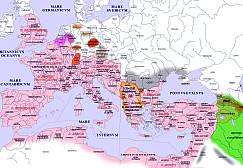

An Online Encyclopedia of Roman Emperors
Flavius Basiliscus (AD 475-476)

Hugh Elton
Florida International University Flavius Basiliscus was the brother of Verina, Leo I's widow and probably came from the Balkans.[[1]] He was married to Zenonis and they had a son, Marcus. Basiliscus had a military career under Leo and reached the consulate in 465. Besides fighting in the Balkans, he was in command of the disastrous expedition against the Vandals in 468 and in the coup against Aspar in 471. After the accession of Zeno in 474, Verina began to plot against him, with the intention of replacing him with her brother. With the support of Theoderic Strabo, Illus and his nephew Armatus, Basiliscus was acclaimed as Augustus on 9 January 475. Zeno fled to Isauria, where he was pursued by troops loyal to Basiliscus.
Despite a strong beginning, Basiliscus rapidly lost support in the capital. He was forced to make strong financial impositions to support the war against Zeno. Then he issued an anti-Chalcedonian Encyclical in 475. This lost him the support of the Constantinopolitan Church and population in 476. He executed Patricius, the magister officiorum, with whom his sister was having an affair, causing her to start motions to bring back Zeno. Basiliscus also failed to keep promises made to Illus and to Armatus. Lastly, there was a severe fire in the city 475/6. With such a lamentable situation in Constantinople, it is hardly surprising that, in the course of operations against Zeno, the exiled emperor was able to detach Armatus and Illus from their allegiance to Basiliscus. In August 476 Zeno marched on Constantinople. When they arrived there in late August, Zeno was able to exploit the tensions caused by Basiliscus' Encyclical to force him from power without fighting. Basiliscus and his family took refuge in a church. Zeno promised not to execute them, so he exiled them to Limnae in Cappadocia and subsequently starved them to death.
Bibliography
For references to primary sources, see entries in RE or the PRLE. Translations of much of the source material can be found here in Ralph Mathisen's DIR essays on the "Shadow Emperors", or in C.D. Gordon ( The Age of Attila: Fifth-Century Byzantium and the Barbarians [Ann Arbor, 1960]) and R.C. Blockley (Fragmentary Classicizing Historians of the Later Roman Empire [Liverpool, 1983], vol. 2.).
Brandes, W., "Familienbände? Odoaker, Basiliskos und Harmatios", Klio 75 (1993): 407-437.
Hartmann, L., RE 3 (1899), 101-102.
Kent, J.P.C., Roman Imperial Coinage volume 10 (London, 1994), 112-115.
Krautschick, S., "Zwei Aspekte des Jahres 476", Historia 35 (1986):344-371
________., "Die unmögliche Tatsache: Argumente gegen Johannes Antiochenus", Klio 77 (1995): 332-338
Prosopography of the Later Roman Empire, vol. 2, ed. J.R. Martindale (Cambridge, 1980)
Redies, M., "Die Usurpation des Basiliskos (475-476) im Kontext der aufsteigenden monophystischen Kirche", Antiquité Tardive 5 (1997): 211-221
NOTES
[[1]]Krautschick has recently argued that Armatus (Basilicus' nephew) and Odoacer were brothers, thus making Basiliscus a barbarian and Odoacer's uncle. This view has been opposed by Brandes. Krautschick's argument depends on a close reading of a Greek fragment. Philologically his arguments are accepable, but they do not account for the total silence to this origin or relationship in other sources.
Copyright (C) 1998, Hugh Elton. This file may be copied on the condition that the entire contents, including the header and this copyright notice, remain intact.
Comments to: Hugh Elton.
Updated:10 June 1998
For more detailed geographical information, please use the DIR/ORBAntique and Medieval Atlas below. Click on the appropriate part of the map below to access large area maps.
